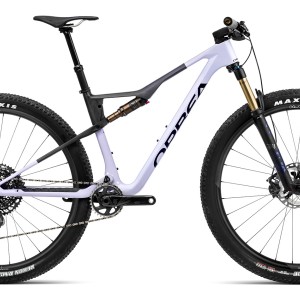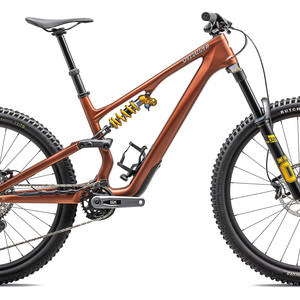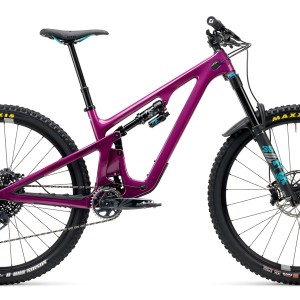2014 Marin Mount Vision Carbon XM Pro
(discontinued)
| Where To Buy | |||
|---|---|---|---|
Free shipping on orders over $50 (continental U.S. only).
International shipping available. Some exclusions apply. |
|||
Free shipping on orders over $50 (continental U.S. only).
International shipping available. Some exclusions apply. |
|||
Reviewed by Steve Wentz, Evan Turpen and Brandon Turman // Photos by Shawn Spomer and Lear Miller
Born in Marin County, California in 1986, Marin Bikes has a long and rich history in the mountain bike world. Over the years they've produced many rides as iconic as the trails in their backyard. In recent years, however, they've fallen off the radar of many riders. That's all set to change with the introduction of several new bikes and a rebranding. Leading the charge is the Mount Vision, a bike with 140mm of travel, 27.5-inch wheels, and a do-it-all attitude. Interested to see how the new rig rides, we hit the trails in Sedona, Arizona on the full carbon Mount Vision Pro XM during our 2014 Vital MTB Test Sessions.

Mount Vision Pro XM Highlights
- CXR 60T Carbon Main Frame and Swing Arm
- 27.5-inch wheels
- 5.5-inches (140mm) rear wheel travel
- IsoTrac suspension system
- Tapered head tube
- 67.5-degree head angle
- 74-degree seat tube angle
- 13-inch (330mm) bottom bracket height
- 17.1-inch (435mm) chainstay length
- 142mm x 12mm thru-axle
- Measured weight (size Medium, no pedals): 26-pounds 7-ounces (12.0kg)
- $7,800 MSRP
The Mount Vision makes use of a simplified suspension design called “IsoTrac.” While it looks like a traditional four-bar linkage, the pivot near the dropout has been eliminated and replaced by flexible carbon fiber seat stays. Marin developed the design in an effort to lose some frame weight by reducing the number of pivot bearings. Why was the weight a primary focus? Because the bike is billed as an Enduro race bike, where weight may be a concern. The entire bike weighs 26.4-pounds and was the third lightest in our 25 bike Test Session lineup.

Compared to Quad-Link, Marin's other suspension design with an added pivot point, IsoTrac is nearly half a pound lighter. As the suspension cycles, the 3.5-degrees of flex occurs in the seat stays, not far from the 12x142mm rear axle. All this talk of flex may have you thinking the bike has a noodly rear end, but thanks to a beefy box section chainstay yoke behind the BB that isn't the case. The pros of this type of system are usually fewer moving parts and increased frame stiffness due to fewer pivots. One con is that the flex can have an impact on suspension performance.
A high-volume FOX Float X CTD rear shock complements the progressive IsoTrac leverage curve and is very accessible on the fly. Unfortunately the rebound knob is difficult to reach without the use of a small allen key, though this is FOX issue.
New for 2014, Marin’s high-end bikes use sealed cartridge Enduro Max Black Oxide linkage bearings that feature a lifetime warranty. The bearings have more balls and a larger diameter than used in prior Marin bikes.
The frame's front end uses a one piece carbon fiber monocoque with bonded metal inserts. Out back, the rear triangle is molded using two pieces. The chainstay yolk is one piece and the chainstay/seatstay is the other. Marin stresses the use of continuous fibers through the stays to help ease concerns about long term durability surrounding the flex.
Full internal cable routing enters through the headtube. If you'd prefer to go external with your cables, they can be routed through the custom-molded “FRS Rock Shield” on the down tube that also protects the frame from impacts. Additional mounts are available under the top tube. Internal routing for the Reverb Stealth dropper post cleans things up nicely.

Small details include a thick rubber chainstay guard, a water seal on the seatpost clamp, bottle mount inside the front triangle, and torx pivot hardware. There’s a modular BB interface that allows the use of ISCG05 tabs or a chain drop backplate for either a double or triple crankset. It also has a high direct front derailleur mount and comes with an e*thirteen XCX guide bolted to the mount for added chain security. Mud clearance is pretty good with ~1cm of room with the stock 2.35-inch Schwalbe tire.
Marin offers a total of six Mount Vision models giving you a wide variety of spec options. The full carbon frame models fall at $7,799 (tested), $6,699, and $5,199, plus a Women’s build at $4,899. There are also two more affordable models with aluminum front triangles and carbon swingarms running $4,099 and $2,099.
On The Trail
We tried the Mount Vision on a wide variety of trails surrounding the Sedona area. From the high-speed fun of Slim Shady, Huckabee, Girdner, Last Frontier, and Ridge to the technical masterpieces of HiLine, Hangover, and Old Post, we feel like we put the bike through just about every kind of terrain from mild to wild. Dirt conditions were pretty amazing following a recent dusting of snow during the winter months.
While the stock 60mm stem and 711mm bar are a decent choice for this style of bike, most riders will prefer a slightly wider bar for more stability. We tend to prefer roomy bikes, and the size Medium test bike felt decent with a 60mm stem, but perhaps a tad short for riders in the 5’10” range. Unfortunately Marin doesn’t list reach/stack measurements which can make sizing a little more difficult. For riders that prefer a long reach, consider sizing up. Make sure your legs are long enough before committing to a bigger frame though. Because the seat tube is bent, the RockShox Reverb seatpost cannot go into the frame fully, effectively creating a taller minimum seat tube height.
The Mount Vision has a 67.5-degree head angle, 74-degree seat angle, 17.1-inch chainstays, and 13-inch BB height. This geometry is very neutral with neither a front or rear weight bias, and with the stock cockpit components installed we felt like we could move around the bike easily. The seat position is also quite good. The head angle makes for a ride that works well as an all-rounder and is well suited for climbing and agility, but can become a hindrance once pointed down steep and rough terrain.

Pointed downhill, the bike excels at fast, flowy, rolling, pumpable terrain with an almost slalom-like feel to it. It’s responsive when you push into it, precise, easy to change lines, and loves to flow dynamically down the trail. You can really feel the side-to-side stiffness of the rear end when bashing through successive turns. Thanks to the chainstay length and axle path, popping the front end up into a manual or picking up over obstacles comes naturally and doesn’t require a big effort.
On steep and rough sections we found that the bike has a bad tendency to push the rider forward, likely as a result of the rear suspension staying high in its travel. This occurred even when we experimented with increasing the rear sag to around 30-35% and upping the pressure in the fork. Slowing the rebound made the bike feel dead, so we kept that pretty constant as we prefer a lively ride. As a result of the tendency to pitch our weight forward, it would often feel a tad sketchy when the trail made drastic pitch changes, and we found ourselves hesitating on a handful of steep sections that we’ve bombed down multiple times before on other bikes. For the rider who might be coming from a gravity background who wants to really push it, perhaps in an Enduro race situation, this can be a confidence killer.
Suspension performance was a mixed bag. Small bumps often felt a bit harsh regardless of the compression settings, almost as though the flex stays were resisting the input. Top end rebound was also a bit too quick for our tastes, likely also a result of the flex stays. They tended to resist small compressions and then rebound very quickly. This could be more apparent to lighter riders. Once you get into the travel further the bike performs better. The mid-stroke is very sensitive and active giving you great traction and control over loose terrain, exceeding our expectations for a 140mm travel bike. It stayed up in the travel through chatter and never seemed to be out of place. Because of how supple the mid-stroke is, rider inputs can be a bit muted at times. Square edge hits were good, partially due to the wheel size. G-outs, drops, and jumps were absorbed with a very controlled feeling on compression and rebound, and it bottoms out smoothly.
One of our tester riders had a problem with hitting his knee on the rocker link. The link is sharp and wide, and his back leg positioned his knee in a prime place to hit the link a few times each ride. This would be a non-issue for those who ride in knee pads.

As we’ve said in other reviews, the 140mm FOX Float 32 CTD fork was a bit of a let down. While the 32mm stanchions save weight, they give up a lot of the stability, precision, and confidence that comes with a larger stanchioned fork. It’s unfortunate because of how the Mount Vision’s rear suspension works. Bumping the fork up to a lowered 34mm stanchion option would greatly improve front end handling, especially when things get steep and off camber.
In general the Mount Vision feels decently light on the trail, but not as light as you’d think having looked at the scale. The weight is centralized in the frame, making for easy direction changes and a snappy feel. It also rolls fairly well, but we didn't feel like it was a rocket ship like many other sub 27-pound bikes often are. This is in part due to the noticeable bob under hard pedaling efforts, which is an issue in all but the firmest of CTD settings. Unfortunately in the firmer CTD settings you give up a lot of the smooth ride and amazing chatter absorption that this bike excels at.
Seated climbing is much more efficient than standing. On smoother fire road climbs the CTD lever needs to be set to “Climb” mode in order to pedal efficiently with minimal bob. Once off-road with the CTD lever set to “Descend” there was quite a bit of rear wheel traction. Overall the geometry was very conducive to climbing efficiently, but the rear suspension lacked the anti-squat support needed to make it an excellent climber on smoother trails.
Build Kit
Our top-of-the-line XM Pro test bike was highlighted by FOX, SRAM, Avid, Schwalbe, Formula, and RockShox components. As previously mentioned, we feel like wider bars and a possible fork swap would really benefit the overall ride. Some may find the narrow Fizik saddle to be a bit uncomfortable as well.

Schwalbe’s Nobby Nic tires worked decently well thanks to our hero-dirt conditions, but we’ve had poor luck with them in the past. While they roll quickly, the lightweight casing adds a skittery sensation when smashing through rough/rocky sections. They also typically wear quickly and offer little cornering bite as the side knobs fold over easily.
At 22mm wide internally, the Marin branded Formula Xero Carbon wheelset was plenty wide for a good tire profile while also offering tubeless compatibility. Weight seemed decent for a carbon wheelset, adding a little to the bike’s acceleration. Stiffness wasn’t a concern, nor was hub engagement.
Avid’s X0 Trail brakes worked great. There was plenty of power even with the smaller 180/160mm rotor combo. The modulation was better than most. We never experienced any fade and the lever feel is some of the best in class. Aggressive riders may see benefit from adding larger rotors.
The RockShox Reverb Stealth worked very well for the duration of our test. We appreciate that Marin got the lever placement correct under the left side of the bar. The lever is separate from the brake allowing you to find that perfect spot. Avid/SRAM’s Matchmaker system cleans up the right side of the bar nicely by combining the brake and shifting on one lever mount.
The SRAM XX1 drivetrain was a great match for this bike and the trails we rode. It shifted well while keeping things simple. We’re not certain the e*thirteen XCX top guide is needed given how well the XX1 X-Sync chainring holds onto the chain, although it does add some sense of security. In general the bike was very quiet thanks to the clutched rear derailleur, but we did hear some occasional cable rattling inside the frame.
Long Term Durability
By eliminating a pivot in the back end and instead asking the frame to flex there are definitely some unique stresses being applied to the back of the bike. It's engineered flex, though, and Marin hasn’t seen issues with softening or cracking over any extended lab testing they’ve done. Marin backs their carbon frames with a five year warranty, plus one year for all parts except the tires, tubes, chain, fork, and shock.

What's The Bottom Line?
The Marin Mount Vision XM Pro is a valiant effort at a trail bike, but it's far from what we’d consider to be a proper Enduro race rig. Marin seems to cross some wires here, because the 140mm front/rear Mount Vision is sold as an "Enduro" bike, while their 150mm Attack Trail with its slacker angles and more refined suspension are billed as a "Trail" bike. Somewhat subjective nomenclature aside, those seeking a hard charging bike capable of blasting steep descents should look to the Attack Trail.
What the Mount Vision offers is a fun, light, snappy, progressive, and pretty well equipped ride. It’s very active and smooth in most conditions. When pushing hard on steep or rough terrain it hits the limit and forces the rider to back off. It isn’t the best pedaling bike, but the smooth ride almost makes up for it. At $7,800 there is a lot of good competition, so consider your choice based on the terrain you’ll be riding most often. The rider who enjoys flowy, less demanding trails and wants a very comfortable ride will be at home on this one.
Visit www.marinbikes.com for more details.
Bonus Gallery: 23 photos of the 2014 Marin Mount Vision Pro XM up close and in action
About The Reviewers
Steve Wentz - A man of many talents, Steve got his start in downhilling at a young age. He has been riding for over 17 years, 10 of which have been in the Pro ranks. Asked to describe his riding style he said, "I like to smooth out the trail myself." Today he builds some of the best trails in the world (and eats lots of M&M's).
Evan Turpen - Evan has been racing mountain bikes as a Pro for the last 8 years with his career highlight being selected to represent the U.S. in the 2006 World Championships. More recently he can be found competing in enduro races and having a blast with it. He has helped design, develop, and test products for multiple major mountain bike companies and has an attention to detail well above most.
Brandon Turman - Brandon likes to pop off the little bonus lines on the sides of the trail, get aggressive when he's in tune with a bike and talk tech. In 14 years of riding he worked his way through the Collegiate downhill ranks to the Pro level. Formerly a Mechanical Engineer, nowadays he's Vital MTB's resident product guy.

Specifications
| Where To Buy | |||
|---|---|---|---|
Free shipping on orders over $50 (continental U.S. only).
International shipping available. Some exclusions apply. |
|||
Free shipping on orders over $50 (continental U.S. only).
International shipping available. Some exclusions apply. |
|||





















2 comments
Post a reply to: 2014 Test Sessions: Marin Mount Vision Pro XM